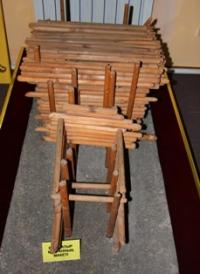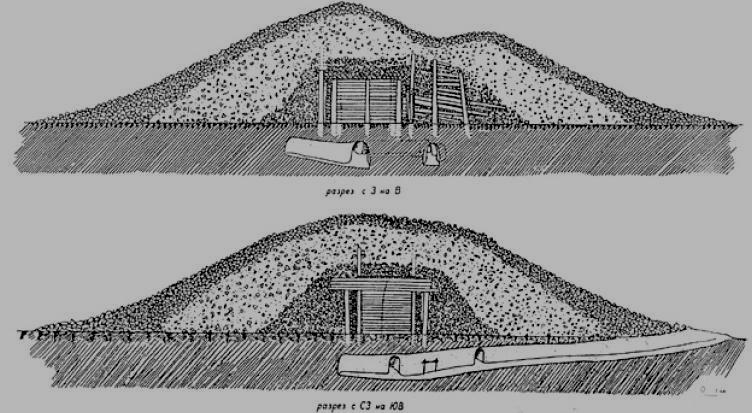You are here
History of burial mounds Besshatyr.

Excursion on burial mounds Besshatyr in Park Altyn-Emel.
“I've known rivers:
I've known rivers ancient as the world and older than the flow of human blood in human veins. My soul has grown deep like the rivers”
Langston Hughes.
Best travel in Central Asia and Kazakhstan.
Kazakhstan is rich with historical and archaeological monuments, which have Republican and global significance. One of the global archaeological monuments is the Besshatyr (five tents) necropolis.
Thousands of years ago, it was a place of worship of the ancient Sakas, who lived on the territory of Kazakhstan. The most significant archeological monument with monumental and compositional complexity of the ancient people - Semirechiya - "Saks" is located in the area of 2 square km.
The necropolis was mentioned first time in the works of the historian Vladimir Gorodetsky. It was about Parfentev's visit burial mounds on the right bank of the Ili River in 1924. After 33 years, Semirechensky archaeological expedition began studying the burial mounds, which was led by K. Akishev.
The area of the Besshatyr cemetery is 2 square km, and length is 2 km from north to south, from west to east is 1 km. The cemetery consists of 18 royal burial mounds with diameter from 8 to 70 m, and height is from 2 to 20.
Similarity of all cemeteries is that they are all common and represent tomb, maze of complex construction: corridor - building - the burial chamber. Each large mound presents a magnificent architectural ensemble, which contains surface and underground facilities: mound, beneath barrow structure - a log tomb, underground passages, catacombs, menhirs, fences and stone ramparts.
The main part of the structure is a huge mound, which consists of several (3 to 17) layers of large stones, gravel and others. Under the ground is underground wooden timbered tomb, which built of large Tien-Shan spruces.
Stratification mounds helped to create a dry microclimate inside of mounds; in order to preserve perfectly the wooden structures of tombs were from moisture and decay. It gives opportunity archaeologists to study in detail and sketch, photograph, and even make the layout of log tombs of the First Hill.
The largest cemetery burial structure is Large Besshatyr mound, which has diameter of 104 m, height – 15 - 17 m. The mound has truncated-conical shape with a stone covers. The distance around the mound is 5 - 7 m, located stone shaft - 2 m wide and 0.6 m high.
A characteristic feature of the mound is two-ring fencing (cromlechs) from huge stone pillars (menhirs) and giant boulders. There were revealed 94 cromlechs around the mound in 1957.
Currently, preserved fences are arranged around the mound in the form of a spiral curl at a distance of 36 to 70 meters from the stone shaft. The diameter of the ring-fence is 2-3 m, and the distance between them is about 3 m.
They were constructed of 5-7 slabs and boulders with height of 1 to 2 m. 3 - 5 large boulders were lined in semicircular, each of them has several hundred kilograms weight. Near Besshatyr also recorded many monuments, which are associated with the necropolis.
Six fences are located on hill, 5 km northeast, and such large Besshatyr barrows. Four cromlechs are located 3 km west from Besshatyr. Finally, 10 km to the west from the burial ground is a long chain of 45 fences, which are stretched from north to south for 450 m, from the terrace of the old waterfront or to the foot of the mountain.
Some of them are stamped with figures of mountain goats, wild boar and wolf. Besshatyr mounds are central part of a huge ritual-funeral complex. Materials, which obtained during excavations, have changed the idea of construction techniques level, methods of treating wood and Saka culture in general.
They suggest that Sakas were able to build complexes from wood, stone, reed and felt. Besshatyr tombs were built by using construction techniques similar to those, which were used in the construction of wooden homes with corridors, passage and doorway, the housing chamber that covered with felt and reed mats.
Tribes, who had inhabited Kazakhstan since the Bronze Age, used this layout of dwellings. One of the main secrets of Besshatyr is underground tunnels. They were found in four large mounds (large, third, fourth and sixth).
The total length of underground tunnels discovered under the mound number 6 - 55 m, the height of the tunnel - 1.0-1.7 m, width - 0.8 m. There was no doubt that tunnels were directly related to burial rituals.
The trough was discovered on the slopes of the mound and terminated with small flat tubercles. During archaeological research, it was found that depression was a former entrance to the underground catacombs, which were opened during the operation of the cult-memorial complex.
Obviously, before conservation of the complex, the entrance was filled up by bringing down part of the mound. The scale of Besshatyr mounds, the complexity of their constructions, unique layout and construction machinery of log tombs, metals of cult-ritual structures add Besshatyr to the great monuments of nomadic Eurasia elite.
Obtained materials during excavations allow restoring one of the large burial mounds of Besshatyr, and creating open-air museum, which will give an opportunity to attract thousands of tourists, including foreigners.
Necropolis refers not only to the cultural and historical monuments, but also to special type of natural and cultural landscapes. According to monumentality and complexity, Besshatyr does not have an analogue in all Central Asia.
Besshatyr monument is sacred "Gerros" of Saks-tigrahauds. Besshatyr Pyramid completes architectural surroundings, and gives fascination and admiration with mystery.

Authorship:
http://culturemap.kz







